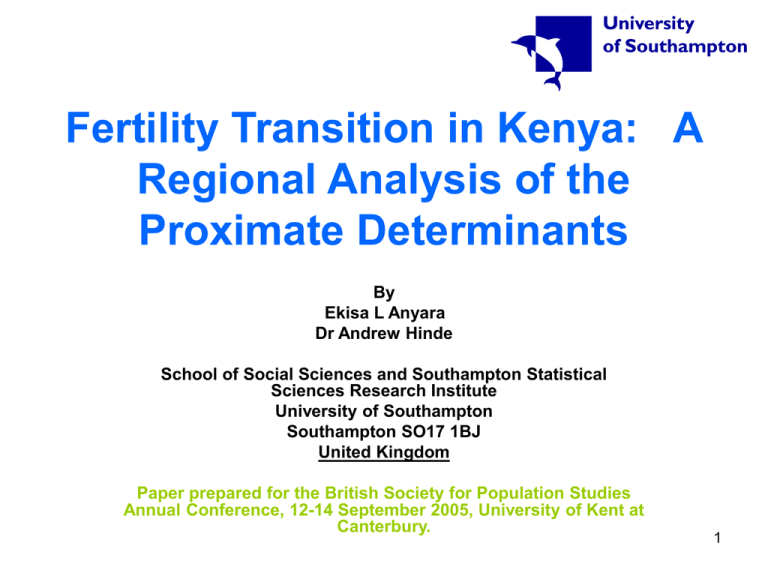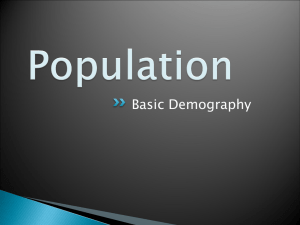Fertility Transition in Kenya: A Regional Analysis of the
advertisement

Fertility Transition in Kenya: A Regional Analysis of the Proximate Determinants By Ekisa L Anyara Dr Andrew Hinde School of Social Sciences and Southampton Statistical Sciences Research Institute University of Southampton Southampton SO17 1BJ United Kingdom Paper prepared for the British Society for Population Studies Annual Conference, 12-14 September 2005, University of Kent at Canterbury. 1 Presentation outline Introduction Kenya Objectives of the Study Data & Methods (Proximate Determinants Model) Confirming the transition Effects of the Proximate Determinants Summary and Conclusion 2 Fertility Transition The study of Human fertility is important. Drastic change in fertility may trigger undesirable changes in other processes of human life Fertility transition has taken place in all continents except in most of Africa. The transition is currently underway in some African countries: Botswana and Kenya . This paper focuses on fertility transition in Kenya. 3 Kenya: Socio-economic setting 100 90 Human Poverty Index 80 70 Absolute Poverty 60 50 40 Primary School enrolment 30 20 Secondary School enrolment 10 0 1989 1993 1995 1997 1999 2003 4 Life expectancy and Infant mortality rates Kenya Mortality and Life expectancy 160 140 120 Infant Mortality 100 80 Life Expectancy 60 40 20 0 1962 1969 1979 1989 1999 Year of Census 5 Study Objective To demonstrate the extent of regional variation in fertility decline in Kenya. To determine the potential role of the proximate determinants in explaining regional patterns of fertility in Kenya since the 1980s. The study question is: What is the contribution of each of the proximate determinants in the regional differentials in fertility in Kenya? 6 Data and methods Data The current study uses Kenya DHS data collected in 1989, 1993, 1998 and 2003. Analysis is based on original districts which are treated as regions Some districts within provinces have been combined into one region Twenty regions have been studied Findings for fifteen regions are presented Computation of fertility rates is based on exact exposure to risk within a four year window We use the proximate determinants model to compute the indexes. 7 Data and Methods The Proximate Determinants Model Bongaarts (1982) distinguished four variables that are mainly responsible for fertility variation among populations. These are: The proportion of women married Contraceptive use Induced abortion and Postpartum infecundity These four variables were quantified using four coefficients namely, Cm is the index of marriage, Cc the index of contraception, Ca the index of Induced abortion and Ci the index of lactational infecundity. The total fertility rate TFR is partitioned into the effects of the above four variables using the equation TFR = Cm.Cc.Ca.Ci.TF. Induced abortion is not included in the current study 8 Data and methods The Proximate Determinants model The indexes measure the fertility reducing effect of the respective proximate determinants Each index takes only values from 0 to 1. A value of 0 means that the determinant completely inhibits fertility while a value of 1 means that it has no effect on fertility. We have reversed the strength of the values for ease of interpretation in some parts of the presentation 9 Data and Methods Modified versions of Bongaarts’ Indexes We present the fertility inhibiting effects of the modified versions of the original Indexes of Bongaarts model. This are: Cm* the index of marriage- no births outside union, Cc* the index of contraception- no Infecundability consideration Cs the index of sterility due to all causes and Ci* the index of Postpartum Insusceptibility Mo a measure of the proportion of births outside marriage The differences are highlighted The fertility inhibiting effects of the modified indexes in births per woman is not presented. 10 Trends in Kenya's Fertility decline, 1989-2003 Total fertility Rates by year of Survey Absolute Realtive Region KFS KDHS difference Decline 198919891978 1989 1993 1998 2003 2003 2003 KENYA 7.9 6.6 5.6 4.7 5.0 -1.6 24.9 Nairobi 4.5 3.4 2.6 2.7 -1.8 40.4 Muranga 5.8 4.4 4.4 3.7 -2.1 36.0 Nyeri/Nyandarua/… 5.7 3.7 3.3 3.6 -2.1 37.1 Kilifi/Kwale 6.4 5.8 6.0 6.4 0.0 0.5 Mombasa 4.3 3.5 3.2 3.2 -1.2 26.9 Machakos/Kitui 7.7 6.2 4.8 5.8 -1.9 24.9 Meru/Embu 5.9 5.6 3.9 3.6 -2.3 39.5 Kisii 6.9 5.9 4.2 4.5 -2.5 35.3 Siaya 6.3 5.9 5.1 5.6 -0.7 11.7 South Nyanza 6.8 6.8 6.4 5.7 -1.0 15.4 Kericho 8.2 6.6 5.5 6.6 -1.6 19.3 Uasin-Gishu 6.8 5.5 5.4 4.7 -2.2 31.7 Narok/Kajiado 6.4 6.8 6.5 8.2 1.4 20.6 Baringo/Laikipia/… 5.3 6.1 5.7 6.3 1.0 17.8 Bungoma/Busia/… 8.2 7.2 6.6 6.3 -1.9 23.011 Kakamega 7.3 6.1 5.2 5.2 -2.0 28.2 Pattern and trend of fertility transition in Kenya 1989-2003 9 KENYA NAIROBI 8 MURANGA NYERI KILIFI MOMBASA MACHAKOS 7 TFR 6 MERU KISII SOUTH NYANZA KERICHO NAROK 5 4 BARINGO UASIN-GISHU BUNGOMA KAKAMEGA 3 2 1979 1989 1993 1998 2003 Year 12 Pattern of fertility decline in Kenya 19892003 Turkana Mandera Legend Moyale Marsabit Decline of over 30% Stagnation from 1998 Wajir West Pokot Samburu Trans Nzoia High steadily declining fertility Marakwet Isiolo Mt Elgon Baringo Teso Lugari/Marava-Lugari Bungoma Uasin Gishu Keiyo Kakamega Busia Butere/Mumias Siaya Bondo Laikipia Sharp rise from 1998 Meru North Nandi Koibatek Vihiga Meru Central Kisumu Tharaka Nyando Kericho Nyandarua Rachuonyo Buret Suba Nyamira/Kisii North Homa Kisii Bay Slight rise from 1998 Embu Kirinyaga Nakuru Muranga Gucha/Kisii South Bomet Migori Kuria Garissa Meru South Nyeri Mbeere Mwingi Maragua Thika Kiambu Trans Mara Narok Nairobi Ijara Machakos Least decline of 1% Tana River Kitui Lamu Kajiado Makueni Malindi Fertility gain from 1993 Area not covered in the study Taita Taveta Kilifi Kwale Mombasa 13 Explanation to Kenya’s fertility Decline Kenya’s fertility decline may have resulted from: A rise in living standards and declines in child mortality (Brass et al. 1993). Massive external pressures (Dow et al. 1994). Increased use of contraceptive methods (Cross et al. 1991, Blacker 2002). These explanations are neither clear nor conclusive. They do not account for the regional fertility differential in Kenya. Fertility decline in areas with low contraceptive use is not explained. The effect of the proximate determinants is little known 14 Effects of the Proximate Determinants on Fertility 1989 Indexes of the Original Bongaarts Model Cm Cc Ci Cp Region MeanD of Origina. BreastF Pathol. TFR/TMFR. model equat. Sterility KENYA NAIROBI MURANGA NYERI KILIFI MOMBASA MACHAKOS MERU KISII SOUTH NYANZA KERICHO NAROK BARINGO UASIN-GISHU BUNGOMA KAKAMEGA Modified versions of the Original Indexes Cm * Mo Cc * Ci * Cs 0.83 0.77 0.77 0.75 0.81 0.76 0.85 0.79 0.83 0.89 0.88 0.99 0.79 0.80 0.86 0.83 0.80 0.71 0.71 0.60 0.91 0.78 0.79 0.65 0.82 0.96 0.83 0.76 0.76 0.86 0.91 0.87 0.61 0.67 0.66 0.65 0.62 0.69 0.64 0.55 0.66 0.64 0.60 0.66 0.67 0.67 0.60 0.63 1.04 1.04 1.04 1.05 1.05 1.05 1.05 1.05 1.05 1.05 1.05 1.04 1.05 1.05 1.05 1.05 N 4765 519 227 499 364 147 341 220 245 290 267 56 66 235 410 335 TUFR/ TMFR 0.70 0.59 0.59 0.66 0.77 0.63 0.69 0.64 0.71 0.89 0.78 0.92 0.67 0.70 0.79 0.75 Births out Infecundit Sterility side y Consid. Postpart. from all Union removed Insuscept. causes 1.18 1.30 1.32 1.13 1.06 1.20 1.22 1.25 1.17 1.14 1.12 1.07 1.18 1.13 1.09 1.11 0.81 0.73 0.73 0.63 0.99 0.80 0.81 0.68 0.83 0.96 0.85 0.77 0.78 0.87 0.92 0.88 0.67 0.75 0.72 0.66 0.68 0.82 0.71 0.67 0.63 0.60 0.70 0.54 0.84 0.74 0.64 0.67 0.81 0.71 0.77 0.78 0.75 0.68 0.89 0.83 0.84 0.78 0.91 0.87 0.77 0.88 0.85 0.86 15 Cc & Ci Overestimate the inhibiting effect of Contraception and Lactaional Infecundity on fertility Cm Underestimates the inhibiting effect of marital patterns on fertility Effects of the Proximate Determinants on Fertility 2003 Indexes of the Original Bongaarts Model Cm Cc Ci Cp MeanD of TFR/ Origina. BreastF Pathol. TMFR. model Equat. Sterility N Modified versions of the Original Indexes Cm * Mo Cc* Ci* Cs Births out TUFR/ side TMFR Union Sterility Infecundity Postpart. due to Consid. Insuscep all removed t. causes Region KENYA 0.74 0.70 0.62 1.04 4919 0.63 1.18 0.72 0.66 NAIROBI 0.56 0.57 0.67 1.04 567 0.45 1.25 0.60 0.77 MURANGA 0.76 0.50 0.68 1.05 119 0.58 1.30 0.54 0.69 NYERI 0.68 0.45 0.66 1.05 345 0.55 1.23 0.49 0.63 KILIFI 0.89 0.89 0.57 1.04 234 0.76 1.16 0.90 0.65 MOMBASA 0.62 0.71 0.69 1.04 175 0.51 1.23 0.73 0.78 MACHAKOS 0.77 0.70 0.57 1.04 321 0.64 1.21 0.72 0.66 MERU 0.68 0.48 0.56 1.04 238 0.58 1.19 0.52 0.72 KISII 0.76 0.62 0.68 1.04 235 0.65 1.16 0.64 0.65 SOUTH NYANZA0.89 0.69 0.64 1.04 229 0.79 1.14 0.72 0.64 KERICHO 0.83 0.69 0.65 1.05 147 0.72 1.15 0.72 0.71 NAKURU 0.73 0.70 0.70 1.05 146 0.61 1.20 0.72 0.64 NAROK* 0.90 0.82 0.55 1.05 143 0.77 1.16 0.83 0.47 BARINGO 0.80 0.84 0.63 1.04 149 0.73 1.09 0.85 0.57 UASIN-GISHU 0.70 0.72 0.66 1.04 127 0.57 1.22 0.74 0.68 BUNGOMA 0.77 0.76 0.63 1.04 266 0.69 1.12 0.78 0.69 KAKAMEGA 0.79 0.72 0.63 1.05 328 0.69 1.15 0.74 0.67 The fertility inhibiting effect of C s is increasing over time surpassing contraception in some areas The fertility inhibiting effect of C s is most felt in low fertility areas 0.75 0.67 0.69 0.63 0.80 0.66 0.77 0.66 0.66 0.76 0.81 0.69 0.85 0.91 0.72 0.86 0.81 16 Effect of each of the Proximate Determinants 1989 10 Inhibition in Births per Woman 9 8 KENYA NAIROBI MURANGA NYERI KILIFI MOMBASA MACHAKOS MERU KISII SOUTH NYANZA KERICHO NAROK BARINGO UASIN-GISHU BUNGOMA KAKAMEGA 7 6 5 4 3 2 1 0 CM CC CI Proximate Determinants CP 17 Effect of each of the Proximate Determinants 1993 10 Inhibition in Births per woman 9 KENYA NAIROBI MURANGA NYERI KILIFI MOMBASA 8 7 6 MACHAKOS MERU KISII SOUTH NYANZA KERICHO 5 4 3 NAROK BARINGO UASIN-GISHU BUNGOMA KAKAMEGA 2 1 0 CM CC CI Proximate Determinants CP 18 Effect of each of the proximate Determinants 1998 9 Inhibition in Births per woman 8 KENYA NAIROBI MURANGA NYERI KILIFI MOMBASA MACHAKOS MERU KISII SOUTH NYANZA KERICHO NAROK BARINGO UASIN-GISHU BUNGOMA KAKAMEGA 7 6 5 4 3 2 1 0 CM CC CI Proximate Determinants CP 19 Effect of each of the proximate Determinants 2003 9 Inhibition in Births per woman 8 7 KENYA NAIROBI MURANGA NYERI KILIFI MOMBASA MACHAKOS MERU KISII SOUTH NYANZA KERICHO NAROK BARINGO UASIN-GISHU BUNGOMA KAKAMEGA 6 5 4 3 2 1 0 CM CC CI Proximate Determinants CP 20 The relationship between fertility and the proximate determinants 0.6 Proximate Determinants Index 0.5 0.4 Linear (1-Cc) Linear (1-cm*) Linear (1-Ci) 0.3 0.2 0.1 0.0 2 3 4 5 6 TFR 7 8 21 The relatioship between fertility and the proximate determinants including Cs 0.6 Proximate Determinants Index 0.5 0.4 Linear (1-Cm*) Linear (1-Ci) Linear (1-Cc) Linear (1-Cs) 0.3 0.2 0.1 0.0 2 3 4 5 6 TFR 7 8 9 22 Summary & Conclusion Kenya’s fertility has declined by 37 per cent since 1978 Pastoral regions show gains in fertility Low fertility in the urban regions of Nairobi and Mombasa appear to be partly a function of marital patterns Low fertility in some rural regions which according to literature have high human development Index tends to be explained by contraception. The effect of sterility due to all causes is increasing considerably especially in regions with low fertility The effect of Postpartum Non-susceptibility is highest in regions other than the urban ones Kenya’s fertility decline appears to have been driven by other factors and also by contraception as far as the current analysis of the proximate determinants is 23 concerned.




